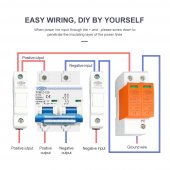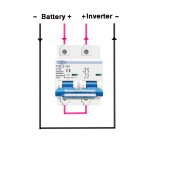hgg
New Member
- Joined
- Sep 5, 2022
- Messages
- 41
Hi,
I just found out that DC circuit breakers not only have polarity but current flow direction as well...
I recently bought the TOMZN TOB1Z-125 C100 125A circuit breaker because I wanted to connect it
between the battery, 24V 100Ah and the hybrid inverter MPPSolar PIP-2424MSE1.
If you have a look at the connection diagram of the DC breaker, you will see that positive goes
to the left and negative to the right. Not only that, but input is at the top and output from the
bottom side.
The problem is that the current direction between the inverter and the battery is bi-directional.
The battery will both be charged and supply current as well.
It looks like that the particular DC breaker is not compatible with my setup.
Correct?
If this is the case, are there any bi-directional (load/line) DC breakers that you can suggest?
Thank you.
I just found out that DC circuit breakers not only have polarity but current flow direction as well...
I recently bought the TOMZN TOB1Z-125 C100 125A circuit breaker because I wanted to connect it
between the battery, 24V 100Ah and the hybrid inverter MPPSolar PIP-2424MSE1.
If you have a look at the connection diagram of the DC breaker, you will see that positive goes
to the left and negative to the right. Not only that, but input is at the top and output from the
bottom side.
The problem is that the current direction between the inverter and the battery is bi-directional.
The battery will both be charged and supply current as well.
It looks like that the particular DC breaker is not compatible with my setup.
Correct?
If this is the case, are there any bi-directional (load/line) DC breakers that you can suggest?
Thank you.




